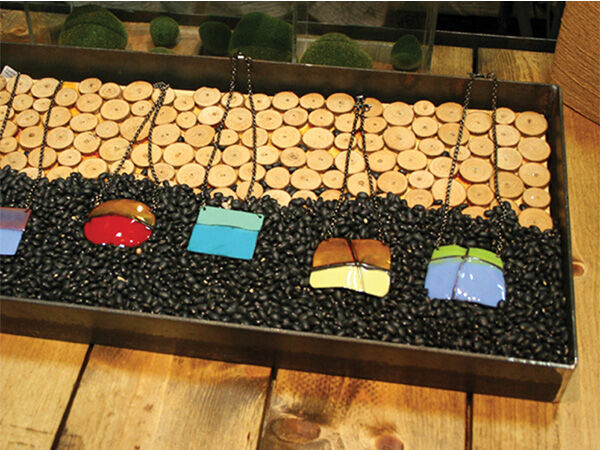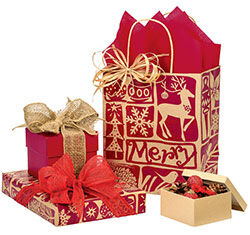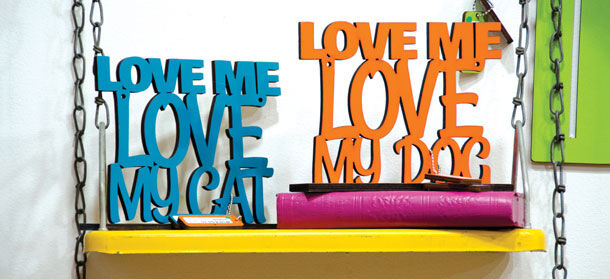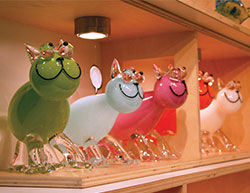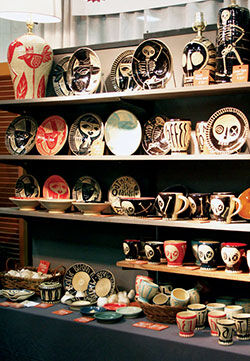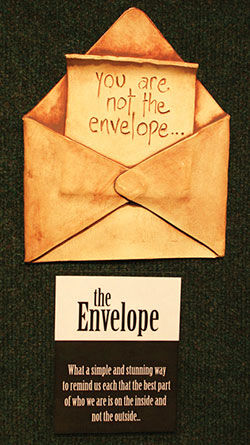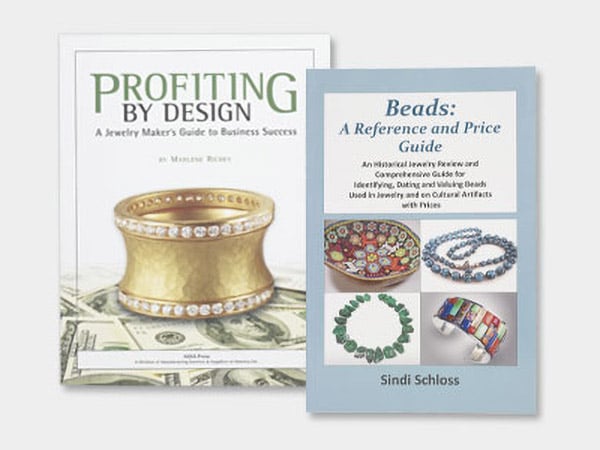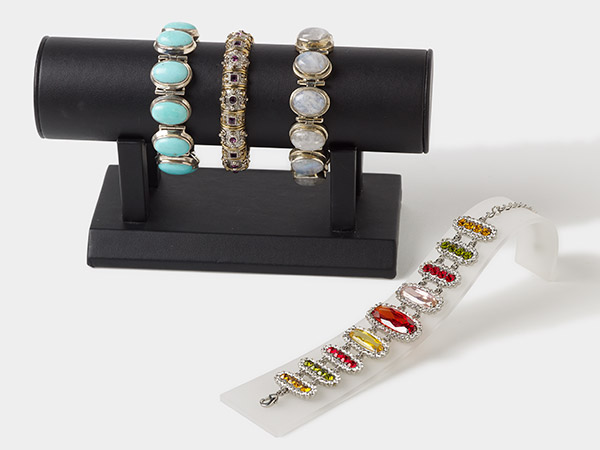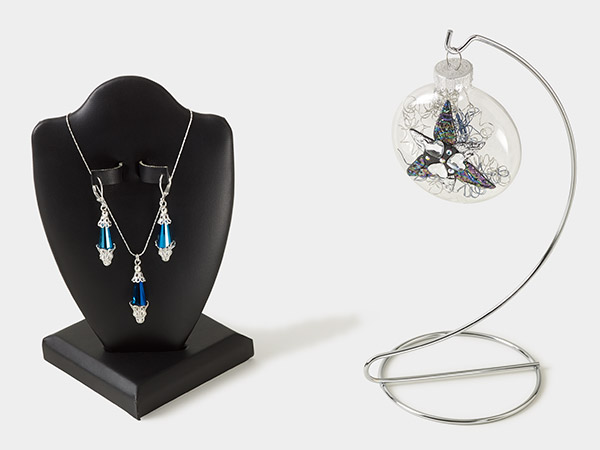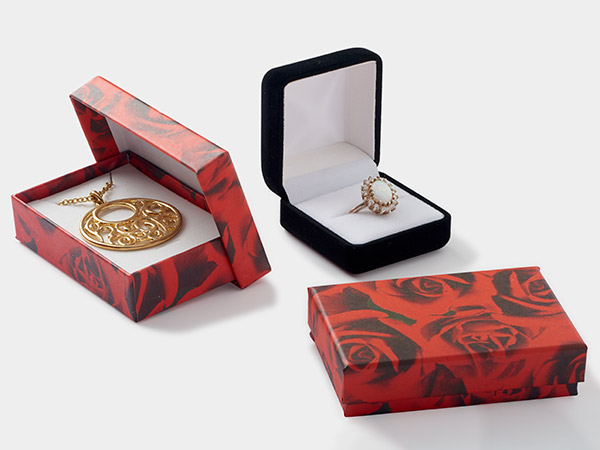Trade Show Presentation
Karen Smith Metalwear beautifully offsets the bright colors of her enameled metal jewelry with a solid color background made from everyday materials.
How to display your products to gain sales
Trade shows can make it or break it for you as a wholesale artist. Being in the retail industry, you must remember most buyers are very visually oriented. First impressions are everything, so make sure your booth is a well-designed steward for your brand. Make your next show your best show ever by following these simple tips!
The Importance of Branding
Good display starts with great branding. Today, more than ever, competition is intense and good branding is important to set yourself apart. All other things being equal, a well-branded seller will outsell another that doesn't have a clear-cut "brand."
Arrive prepared with business cards, bio cards, and a well-merchandised line sheet. Your line sheet should be prepared with all product information listed on it along with good photos and pricing information. Choose a simple, graphic way to point out your best sellers and new items. Pull your work into ready-made collections and sweeten the deal by giving a small discount on them. Make it a no-brainer for them to say "I'll have your Starter Pack please!" Have a show special--give buyers an incentive to write their order now!
Creative Booth Displays
The first rule craft show exhibitors need to remember is the eye likes to roam and take in the entire display. A person gets a feel for the booth and the crafts available through the presentation and level of professionalism created in the booth. There is a psychological benefit to having the sensation of abundance within your display--but that does not mean clutter! Abundance versus clutter makes the customer feel that the exhibitor is a professional--clutter does not develop a sense of quality or tastefulness. Beyond the struggle between abundance and clutter, one finds the realm of emptiness. You don't want your booth to look confusing, nor do you want it to look "picked clean." Using shelving for larger items is great. The space between the items can be used as a statement by treating each item as it is important.
The more creative your use of space, the better your chances of engaging customers. Creativity should not be confused with complexity. Your displays should enhance, but never outshine, your product. Each display is there to make your product stand out.
Having a theme to your booth reinforces your brand. Well thought-out booth display themes can give you an edge on your competition. For example, if you sell linens, you could use vintage wire laundry baskets to display some of your items or an old-fashioned washboard as a display stand. It's great to have functional props, too, so try and choose ones that can be used as levels or stands.
Color and Lighting
When planning your displays, choose pleasing and current colors that make your products pop. You don't want your items to be washed out by a color that is dated, bland, or overwhelmed by bold or busy patterns. Always keep your brand in mind when choosing colors. Think about the mood you want to create when people visit your booth. Do you want your booth to energize buyers? Choose yellow. Soothe them? Choose green. Consistency in theme and color is necessary if you want a positive response from every visitor to your booth. It gives you the ability to make yourself easily remembered and recognized, which is the name of the game.
Lighting is probably the easiest thing to do to make your booth instantly more attractive. Good lighting sets the mood and helps create ambiance. Light it up! Absolutely never, ever rely on the in-house lighting. It is gray and dull and just does not do the trick. Conversely, some vendors completely overdo it (jewelry artists are often the main culprit here). Remember that a booth with obnoxiously bright lighting is a huge turnoff. Buyers' eyes get very tired at shows, so throw out the bright white and fluorescent lights. Use warm, comfortable lighting to highlight specific pieces that need it. This can be a tricky game that may require some experimentation to get right.
Add Depth to Your Displays
Include levels and depth to make your displays interesting and to draw people in. From a distance, your booth will look empty, boring, and uninviting if your products are all laying flat on a table. Use risers and stands to raise them up to face the customer. Creating levels diversifies the visual presentation and increases the room you have to display items. Note your choice items should always be displayed at eye level.
Don't forget the floor and ceiling space when creating the environment of your booth. Think of ways to utilize them to add visual touches. Adding a rug to the floor provides a functional use of comfort and can tie the space together, and hanging a grid from the top of the booth space provides additional options for displaying your products.
Signs and Packaging
Make sure you have a highly visible sign with your business name on it (don't just use the sign provided by the show). Make it interesting and unique--your company name, after all, is one of your most important business assets. If you are displaying small items such as jewelry, use large graphics in your display to grab the attention of buyers as they walk by.
Also, just like when shopping at a retail store, buyers want to know prices. It certainly can be annoying for a buyer to repeatedly have to ask how much everything costs. What if you are busy with another customer? Without this basic product information, the customer may just walk away rather than ask for help. Everything in your booth should be tagged, labeled, and identified for the customer.
Your signage should speak for you when you are occupied with other customers--keep it clean, concise, and informative. Include your terms, prices, show specials, package deals, and what your product is all about.
If you make a sale that will be carried away that day, be sure to have packaging that matches your brand. Tissue paper, item tags, gift bags, and boxes should all coordinate with your products and the "look" you have chosen for your company. And, if possible, try to adjust your packaging to fit the season. For example, if your line features woodsy, Scandinavian-inspired items, the packaging shown on page 15 would be perfect for purchases made around Christmastime. This simple gesture makes you memorable, draws attention from other buyers, and is more protective to your products than a thin plastic bag!
Providing Options
Help buyers picture your products in their store with ready-made displays and ideas. If you have been around the block before or have a best-selling item, offer new ideas on how to sell or re-merchandise your line. Be willing to sell your displays, if possible! Think of it as an add-on sale.
Buyers like choices, they like easy, and they like well-curated collections. However, they are often easily overwhelmed when looking at new collections, so help them out. Offer incentives for those who purchase entire collections. Your products will likely sell better for them, encouraging multiple reorders--and you'll feel confident your work is displayed well in their store.
Make sure buyers are comfortable handling your products. Put the items in their hands or encourage them to pick them up.
Just like in retail stores, buyers are significantly more likely to purchase something they are holding. Products that can withstand rough handling should be displayed differently than those that need more careful handling. If handling an item is problematic, perhaps a glass case can be used or access to the piece can be limited by requiring your assistance. If you want some things to be touched and others not as much, be sure to work that into the design of the booth and the flow of traffic.
Just the Basics
For beginners, it is important to take photos of your booth and practice putting it together and taking it apart. You don't want to leave the final outcome for the day of the show. Plan appropriately to be able to set up and have a break to freshen up before the show starts. This is especially important if you don't have backup.
Also be sure you understand what you need and how long it will take to pack your materials, transport everything, set up, and break down the booth. This translates into understanding if you need additional manpower (which includes managing the booth during the show). Show your setup to a layperson to get their feedback and see what questions they might pose. Good luck!
Jennifer Raines is a native Virginian who has owned five retail stores, opening her first at age 19. She has operated some form of her current business since 2005 and currently has a flagship store in Williamsburg, Va., called Quirks of Art, a website and a strong social-media presence. Raines has won numerous honors, including "Top 40 Under 40," Niche magazine's "Top Retailer," and a Women in Business Achievement Award.
Have a question regarding this project? Email Customer Service.
Copyright Permissions
All works of authorship (articles, videos, tutorials and other creative works) are from the Fire Mountain Gems and Beads® Collection, and permission to copy is granted for non-commercial educational purposes only. All other reproduction requires written permission. For more information, please email copyrightpermission@firemtn.com.
